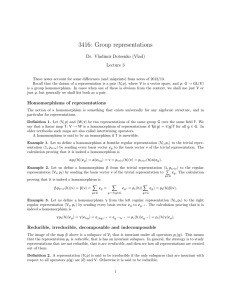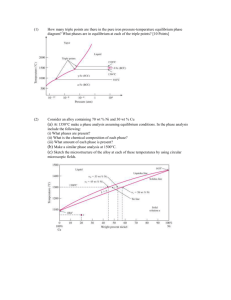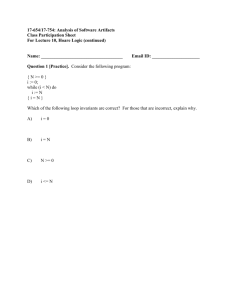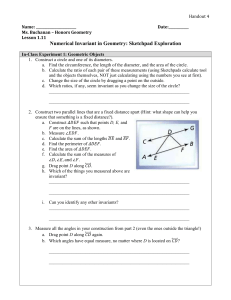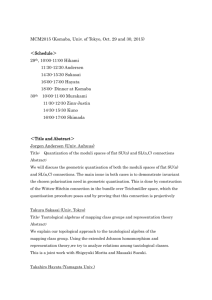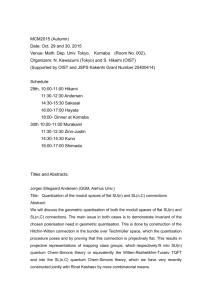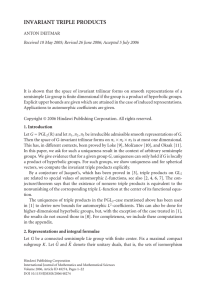3416: Group representations Dr. Vladimir Dotsenko (Vlad) Lecture 4 Complete reducibility
advertisement
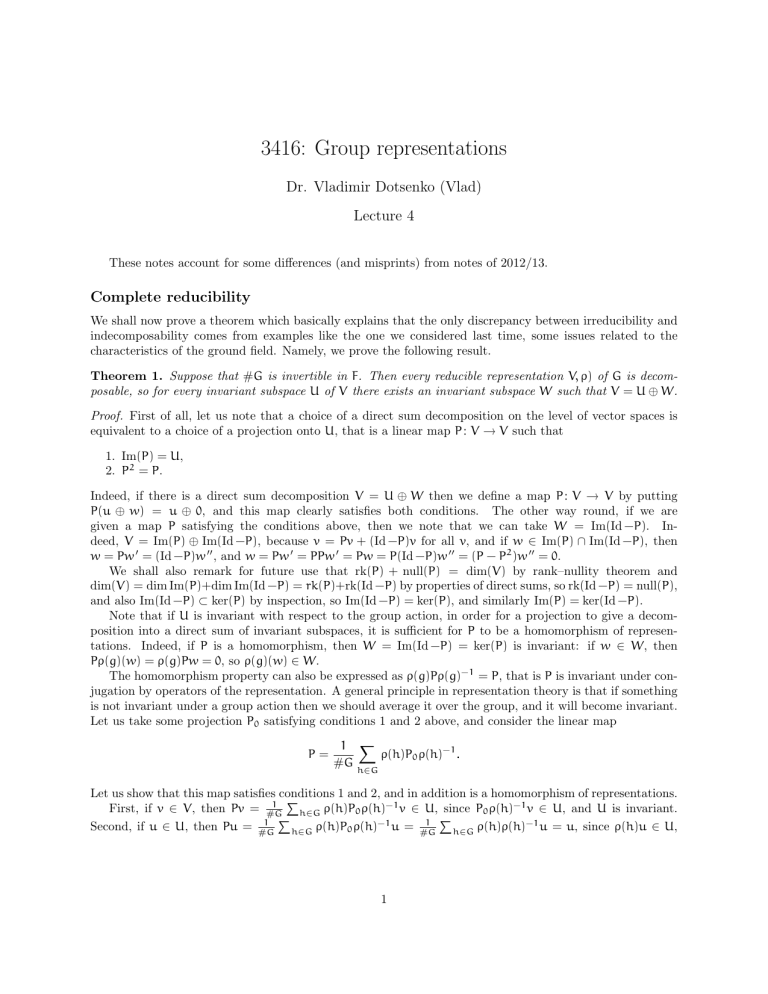
3416: Group representations Dr. Vladimir Dotsenko (Vlad) Lecture 4 These notes account for some differences (and misprints) from notes of 2012/13. Complete reducibility We shall now prove a theorem which basically explains that the only discrepancy between irreducibility and indecomposability comes from examples like the one we considered last time, some issues related to the characteristics of the ground field. Namely, we prove the following result. Theorem 1. Suppose that #G is invertible in F. Then every reducible representation V, ρ) of G is decomposable, so for every invariant subspace U of V there exists an invariant subspace W such that V = U ⊕ W. Proof. First of all, let us note that a choice of a direct sum decomposition on the level of vector spaces is equivalent to a choice of a projection onto U, that is a linear map P : V → V such that 1. Im(P) = U, 2. P2 = P. Indeed, if there is a direct sum decomposition V = U ⊕ W then we define a map P : V → V by putting P(u ⊕ w) = u ⊕ 0, and this map clearly satisfies both conditions. The other way round, if we are given a map P satisfying the conditions above, then we note that we can take W = Im(Id −P). Indeed, V = Im(P) ⊕ Im(Id −P), because v = Pv + (Id −P)v for all v, and if w ∈ Im(P) ∩ Im(Id −P), then w = Pw 0 = (Id −P)w 00 , and w = Pw 0 = PPw 0 = Pw = P(Id −P)w 00 = (P − P2 )w 00 = 0. We shall also remark for future use that rk(P) + null(P) = dim(V) by rank–nullity theorem and dim(V) = dim Im(P)+dim Im(Id −P) = rk(P)+rk(Id −P) by properties of direct sums, so rk(Id −P) = null(P), and also Im(Id −P) ⊂ ker(P) by inspection, so Im(Id −P) = ker(P), and similarly Im(P) = ker(Id −P). Note that if U is invariant with respect to the group action, in order for a projection to give a decomposition into a direct sum of invariant subspaces, it is sufficient for P to be a homomorphism of representations. Indeed, if P is a homomorphism, then W = Im(Id −P) = ker(P) is invariant: if w ∈ W, then Pρ(g)(w) = ρ(g)Pw = 0, so ρ(g)(w) ∈ W. The homomorphism property can also be expressed as ρ(g)Pρ(g)−1 = P, that is P is invariant under conjugation by operators of the representation. A general principle in representation theory is that if something is not invariant under a group action then we should average it over the group, and it will become invariant. Let us take some projection P0 satisfying conditions 1 and 2 above, and consider the linear map P= 1 X ρ(h)P0 ρ(h)−1 . #G h∈G Let us show that this map satisfies conditions 1 and 2, and in addition is a homomorphism of representations. P 1 −1 First, if v ∈ V, then Pv = #G ρ(h)P v ∈ U, since P0 ρ(h)−1 v ∈ U, and U is invariant. 0 ρ(h) P h∈G P 1 1 −1 −1 Second, if u ∈ U, then Pu = #G h∈G ρ(h)P0 ρ(h) u = #G u = u, since ρ(h)u ∈ U, h∈G ρ(h)ρ(h) 1 and U = Im(P) = ker(Id −P). This shows that Im(P) = U since Pu = u for u ∈ U, and also shows that P2 = P since for each v we have Pv ∈ U and hence PPv = Pv. Finally, we have ρ(g)Pρ(g)−1 = 1 1 X ρ(g)ρ(h)P0 ρ(h)−1 ρ(g−1 ) = #G #G h∈G X ρ(h 0 )P0 ρ(h 0 )−1 = P. h 0 =gh∈G This result is called complete reducibility since it says ultimately that every (finite dimensional) representation is isomorphic to a direct sum of irreducible representations, so knowing a representation is completely reduced to knowing its irreducible constituents. Example 1. Let us apply this general result to the invariant subspace U = Im(β) ⊂ Vl . We first find a vector space complement of U: we can take, for instance, the linear span of all vectors eg with g 6= e. Therefore, the projection P0 is given by the formula X X eg , eg ) = P0 ( g∈G g∈G P0 (eh ) = 0 for h 6= e. P P P These two formula together imply P0 (ee ) = P0 ( eg ) − P0 (eg ) = eg . Now, we put g∈G P= g∈G,g6=e g∈G 1 X ρl (h)P0 ρl (h)−1 . #G h∈G On a basis vector eg , we have Peg = 1 X 1 X ρl (h)P0 ρl (h)−1 eg = ρ( h)P0 eh−1 g , #G #G h∈G h∈G and we note that P0 eh−1 g is different from zero only for h = g, and in this case is equal to P eg , so g∈G Peg = X 1 X 1 ρl (h) eg = eg . #G #G g∈G g∈G From this, it is easy to compute Im(Id −P) = ker(P): the kernel of P is spanned by all differences eg1 − eg2 . This span is manifestly an invariant subspace, which also follows from our general result. Let us conclude by outlining a proof of the complete reducibility theorem that works over R and C. The idea is that if we have a positive definite bilinear form (over R) or a positive definite sesquilinear form (over C), or in other words, V is a Euclidean / Hermitian vector space, and the form is invariant, that is (v, w) = (ρ(g)v, ρ(g)w) for all g ∈ G and all v, w ∈ V, then the orthogonal complement of an invariant subspace is also invariant, so it is enough to demonstrate that we can find an invariant form. But that is easy: take any form and average over the group: (v, w) = 1 X (ρ(g)v, ρ(g)w). #G g∈G It is an exercise to fill in the missing details of this proof. 2


